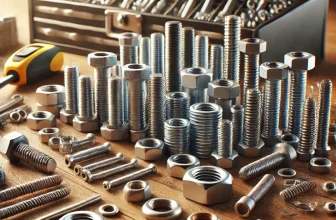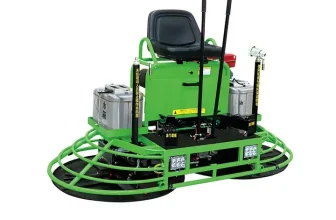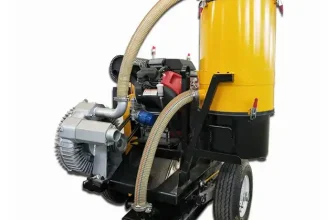Introduction to Concrete
Anchors
What Are Concrete Anchors?
Concrete anchors are specialized fasteners designed for securing
objects to concrete surfaces. These robust connectors create a stable
and reliable attachment, delivering the necessary strength to hold items
such as structural beams, heavy machinery, railings, and more. They come
in various designs and materials, each tailored to meet different
performance criteria and environmental conditions.
Typically, concrete anchors work by creating an interlocking bond
between the fastener and the concrete. This is achieved through
different mechanisms, such as expanding within a drilled hole or bonding
chemically with the concrete material. The proper installation and
selection of the appropriate anchor type are crucial to ensuring safety
and stability.
Concrete anchors are indispensable in both commercial and residential
construction, as well as in DIY projects. They provide the means to
secure heavy loads and vital structural components, making them
essential for maintaining the integrity of buildings, bridges, roads,
and other concrete structures. Whether it’s for mounting a shelf in a
garage or anchoring a steel framework for a skyscraper, concrete anchors
are the unsung heroes that keep our structures safe and sound.
Applications of Concrete
Anchors
Concrete anchors are versatile tools that provide secure fastening
solutions in a variety of settings. Their applications span numerous
industries and projects, making them essential components in both
residential and commercial construction. Here are some key applications
of concrete anchors:
- Construction and Building Projects: Concrete
anchors are vital in securing structures such as walls, beams, and
pillars. They ensure that building elements are firmly attached to the
concrete base, providing stability and strength to the overall
construction. - Mounting Heavy Equipment: In industrial
settings, heavy machinery and equipment need to be securely anchored to
the concrete floor to prevent movement or tipping. Concrete anchors
provide the strength required to hold these machines in place, ensuring
safety and operational efficiency. - Installation of Railings and Handrails: Railings
and handrails in buildings, staircases, and balconies need to be
securely fastened for safety reasons. Concrete anchors ensure these
fixtures are firmly attached, providing reliable support and preventing
accidents. - Securing Structural Components: Concrete anchors
are used to affix joists, studs, and other structural components to
concrete foundations. This application is critical in ensuring the
overall durability and integrity of buildings and other
structures. - Fixing Exterior Features: Outdoor installations
such as light poles, signage, and street furniture require sturdy
anchoring to withstand environmental factors like wind and rain.
Concrete anchors offer the necessary support to keep these features
securely in place. - Retrofitting and Renovations: When modifying
existing structures, concrete anchors are essential for securing new
components or reinforcing old ones. This includes adding new walls,
floors, or supports to enhance the building’s functionality or safety
standards.
Concrete anchors are indispensable for creating secure, stable, and
long-lasting connections in various construction and renovation
projects. They ensure that everything from heavy equipment to essential
safety features is securely fastened, contributing to the overall
reliability and safety of the structure.
Mechanical Anchors
Expansion Anchors
Expansion anchors are among the most commonly used types of
mechanical anchors for securing objects to concrete and other solid
materials. Their popularity is due to their versatility, ease of
installation, and reliable performance in a variety of applications.
These anchors work by expanding within the drilled hole as a bolt is
tightened, creating a secure hold by exerting outward pressure against
the hole walls.
One of the primary advantages of expansion anchors is their ability
to handle substantial loads. This makes them suitable for medium to
heavy-duty applications, such as fastening structural supports,
machinery, or heavy equipment. They are available in various shapes and
sizes, allowing for flexibility depending on the specific requirements
of the project.
Installation is relatively straightforward. First, a hole is drilled
into the concrete at the desired location and depth. The anchor is then
inserted into the hole, and as the bolt or screw is tightened, the
anchor expands. This expansion generates friction and interlocking
forces that hold it firmly in place. Various types of expansion anchors
are available, including wedge anchors, sleeve anchors, and drop-in
anchors, each designed for specific situations and load conditions.
Wedge anchors, for instance, feature a conical end that expands when
the bolt is tightened, providing a strong hold in the concrete. Sleeve
anchors, on the other hand, are surrounded by a sleeve that expands
outwards to grip the sides of the hole. Drop-in anchors require a
setting tool to expand an internal wedge, making them ideal for overhead
applications where the anchor needs to be flush with the concrete
surface.
Choosing the appropriate expansion anchor depends on several factors,
including the load requirements, the type of concrete, and the
environmental conditions. For exterior or corrosive environments,
stainless steel or galvanized anchors are recommended to prevent rust
and degradation over time.
In summary, expansion anchors are a robust and dependable choice for
securing heavy items to concrete structures. Their straightforward
installation process and ability to handle significant loads make them a
go-to solution in construction, renovation, and industrial projects.
Sleeve Anchors
Sleeve anchors are a versatile type of mechanical anchor widely used
in various construction applications involving concrete, brick, and
block materials. They are easy to install and provide reliable holding
power, making them suitable for many medium-duty to heavy-duty anchoring
tasks.
A sleeve anchor consists of a threaded bolt, an expander cone, a
sleeve, and a nut. When the bolt is tightened, the expander cone pulls
into the sleeve, causing it to expand against the concrete or masonry
surface. This expansion provides the resistance needed to hold the
anchor securely in place.
One of the primary advantages of sleeve anchors is their versatility.
They come in different diameters, lengths, and materials, including
zinc-plated, stainless steel, and galvanized versions, making them
suitable for various environmental conditions and load requirements.
Sleeve anchors are also available in different head styles, such as hex
head, flat head, and acorn head, providing options depending on the
specific application and aesthetic requirements.
The installation process for sleeve anchors is straightforward.
First, a hole is drilled into the base material using a hammer drill and
appropriately sized masonry bit. The hole depth should exceed the length
of the sleeve anchor to ensure proper embedment. Next, the anchor is
inserted into the hole, and the nut is tightened, causing the sleeve to
expand and grip the sides of the hole securely.
Sleeve anchors are commonly used for anchoring handrails, lighting
fixtures, signs, and machinery in both residential and commercial
construction. They are also suitable for temporary installations, as
they can be easily removed by loosening the nut and pulling out the
anchor.
In summary, sleeve anchors provide a reliable and versatile solution
for various anchoring needs in concrete and masonry materials. Their
ease of installation, range of sizes and materials, and secure holding
power make them a go-to choice for many construction professionals.
Chemical Anchors
Epoxy Anchors
Epoxy anchors are a type of chemical anchor known for their
exceptionally strong bond and versatility in various construction and
repair applications. These anchors use a two-part epoxy adhesive that is
mixed and injected into pre-drilled holes in concrete. Once the epoxy
cures, it forms a robust bond that firmly secures the anchor in
place.
One of the primary advantages of epoxy anchors is their high
load-bearing capacity. They are ideal for heavy-duty applications that
require significant holding power, such as installing structural
supports, securing heavy machinery, and anchoring safety-critical
installations like guardrails and barrier systems. The strong adhesive
properties of epoxy make it possible to achieve high-strength bonds in
both cracked and uncracked concrete, as well as in environments with
dynamic loads or vibrations.
Another key benefit of epoxy anchors is their adaptability to various
conditions. They can be used in challenging environments, including
underwater applications and in areas exposed to harsh chemicals or
extreme temperatures. This makes them suitable for industrial settings
like chemical plants and wastewater treatment facilities where
conventional mechanical anchors might fail.
The installation process for epoxy anchors is straightforward but
requires attention to detail. The surfaces must be cleaned and free of
debris to ensure proper adhesion. The epoxy components are mixed,
typically using a specialized applicator, and injected into the hole.
The anchor rod is then inserted and allowed to set until the epoxy cures
completely. Depending on the product used, curing times can vary, but
most epoxy systems provide detailed guidelines to ensure optimal
performance.
While epoxy anchors offer superior strength and durability, they do
come with some considerations. The curing time can be a drawback for
projects that require immediate load application. Additionally, proper
storage and handling of the epoxy components are crucial to maintain
their effectiveness, as exposure to extreme temperatures or moisture
before application can compromise the adhesive properties.
In summary, epoxy anchors are a reliable choice for high-load and
specialized applications that demand a strong, adaptable, and durable
anchoring solution. Their ability to perform well in various
environmental conditions and their exceptional bonding strength make
them a preferred option for many construction and industrial
projects.
Acrylic Anchors
Acrylic anchors are a type of chemical anchor that utilizes acrylic
resin to bond and secure fixtures in concrete structures. Known for
their fast curing times and ease of use, these anchors are particularly
beneficial in situations where time is of the essence and rapid
installation is required.
The primary component of acrylic anchors is an acrylic-based resin,
which, when mixed with a hardening agent, forms a strong adhesive. This
adhesive fills the voids and irregularities within the drilled hole in
the concrete, providing a secure bond as it hardens. This mechanism
ensures that the anchor can withstand considerable loads and stresses,
making it a reliable choice for various applications.
One of the standout features of acrylic anchors is their versatility.
They are suitable for both cracked and uncracked concrete and can also
be used with a variety of materials, including brick and block. This
adaptability is crucial for construction projects where the substrate
condition might vary, offering a flexible solution without compromising
on strength or performance.
Acrylic anchors are typically used in installations where speed and
efficiency are crucial. For instance, they are ideal for installing
railings, handrails, staircases, and other fixtures in public buildings,
hotels, and residential complexes. Their rapid curing time means that
the installation process is significantly faster, reducing downtime and
allowing for quicker project completion.
In addition to their quick installation and versatility, acrylic
anchors also demonstrate good resistance to various environmental
factors. They exhibit substantial resilience to moisture and chemical
agents, making them suitable for use in both indoor and outdoor
environments. This resistance ensures the longevity and durability of
the installed fixtures even in challenging conditions.
However, it is crucial to follow manufacturer guidelines when using
acrylic anchors to ensure optimal performance. Proper hole cleaning,
correct mixing ratios, and adherence to curing times are essential steps
to guarantee the anchor’s efficacy and longevity.
In summary, acrylic anchors are a highly effective and versatile
solution for securing fixtures in various types of concrete and masonry
structures. Their quick curing times, adaptability, and resistance to
environmental factors make them an excellent choice for both
professional and DIY projects where efficiency and reliability are
paramount.
Choosing the Right Concrete
Anchor
Load Requirements
When selecting the appropriate concrete anchor for your project, one
of the most critical factors to consider is the load requirement. The
load that the anchor needs to support will dictate the type of anchor to
use, ensuring safety and structural integrity. Load requirements refer
to the maximum weight and forces that an anchor will need to withstand.
This includes both static loads, which are stationary and constant, and
dynamic loads, which can change over time due to movement, vibration, or
environmental factors.
To determine the load requirements, you need to assess the nature of
the application. For example, heavy machinery or large structural
components will exert substantial loads on the anchor, necessitating a
stronger, more robust anchor. Conversely, lighter fixtures such as
shelving or decorative elements may require less heavy-duty anchors.
Different types of anchors are designed to handle different load
capacities. Expansion anchors, for example, are often used for medium to
heavy loads, while sleeve anchors can be adaptive but might be more
appropriate for moderate loads. For very heavy loads or critical
applications, chemical anchors like epoxy or acrylic anchors provide
exceptionally high load-bearing capacity and resistance to shear and
tensile forces.
It’s also essential to consider the direction of the load. Some
anchors perform better under shear forces (forces acting parallel to the
mounting surface) while others excel under tensile forces (forces acting
perpendicular to the mounting surface). Understanding the type of forces
involved will help you choose an anchor that can handle the specific
load conditions of your application.
In summary, accurately determining your load requirements is
fundamental to selecting the right concrete anchor. By understanding the
weight, type of load, and the forces at play, you can ensure that the
chosen anchor will provide the necessary strength and durability for
your project.
Environmental Factors
When selecting the appropriate concrete anchor for your project, it’s
crucial to consider the environmental conditions where the anchor will
be used. Environmental factors can significantly affect the performance
and longevity of concrete anchors. Here are key considerations to keep
in mind:
Moisture and Weather Exposure: If the anchor will be
exposed to high humidity, rainfall, or standing water, it’s important to
choose an anchor material that resists corrosion. Stainless steel
anchors are excellent for wet environments, offering durability and
resistance to rust. Galvanized anchors may also be suitable for mildly
corrosive environments.
Temperature Fluctuations: Environments with extreme
or fluctuating temperatures can cause materials to expand and contract,
potentially weakening the anchor over time. In such cases, it’s wise to
select anchors specifically designed to withstand these stresses.
Chemical anchors, like epoxy, often perform well under variable
temperature conditions due to their strong bonding properties.
Chemical Exposure: Anchors used in industrial
settings may be exposed to various chemicals that can corrode or degrade
standard materials. In these circumstances, choosing anchors made from
materials like stainless steel or those with special coatings can help
ensure long-term performance despite chemical exposure.
Saltwater Environments: If your project is near
coastal areas or involves marine applications, the anchors will be
exposed to saltwater, which is highly corrosive. For these conditions,
marine-grade stainless steel anchors are recommended due to their
superior resistance to salt-induced corrosion.
Outdoor vs. Indoor Use: For outdoor applications,
consideration needs to be given to UV exposure, wind loads, and variable
weather conditions. Anchors made from weather-resistant materials or
those with protective coatings are crucial for maintaining structural
integrity over time. For indoor environments, environmental stresses are
typically less severe, but considerations for humidity and temperature
control are still relevant.
Seismic Activity: In regions prone to earthquakes,
anchors must meet specific codes and standards for seismic performance.
Special seismic-rated anchors are available and designed to provide
additional security and stability in the event of an earthquake.
By carefully evaluating the environmental factors relevant to your
application, you can choose the most suitable concrete anchor, ensuring
both safety and durability for your structures. Always consult with a
structural engineer or anchoring specialist to make the most informed
decision for your specific project needs.







